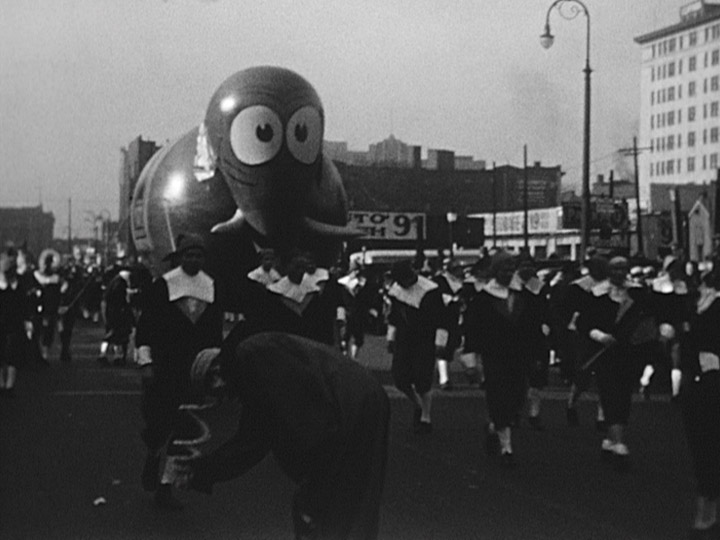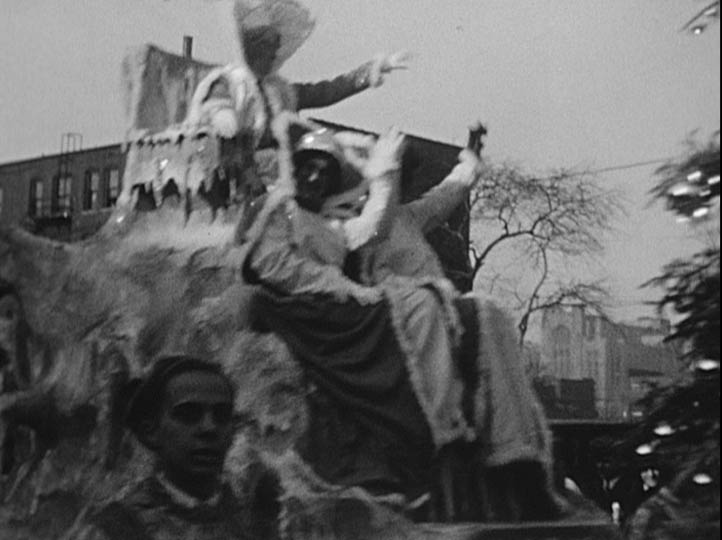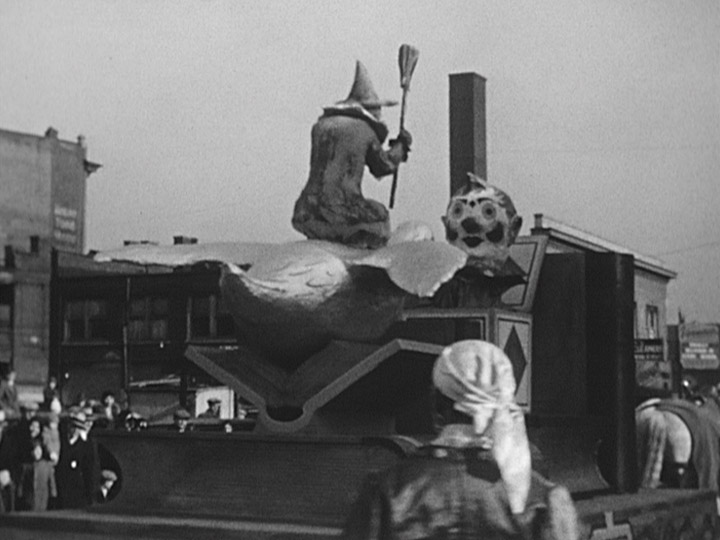Thanksgiving Leftovers
 A group in pilgrim costumes and a clown with a spring-shaped hat march ahead of an elephant float in this still from a film of one of Detroit's first Thanksgiving Day parades.
A group in pilgrim costumes and a clown with a spring-shaped hat march ahead of an elephant float in this still from a film of one of Detroit's first Thanksgiving Day parades.
For 90 years, Mother Goose, Santa Claus, and a host of others have been making an annual trek through the streets of Detroit as part of the Thanksgiving Day parade. The tradition was begun by the J.L Hudson Company in 1924—the same year the Macy’s began their annual parade in New York City. The Hudsonian generally credited for the parade’s creation was Charles F. Wendel, who designed displays for the massive department store. Although 92 years have passed since that first parade, 2016 marks the 90th parade, because the celebration was suspended for two years at the height of World War II. While the parade has grown and changed along with the city, several traditions have remained strong during its nine decades. Recently three films were added to our Detroit’s Video History Archive showing the parade during three very different eras—the mid-1920s, the late 1940s, and 1988. The earlier two clips both come from silent 16mm home movie reels, while the 1988 video comes from a tape shot by someone for the City of Detroit. One of the biggest changes to the parade over the years has been to its route. Now the parade is synonymous with Woodward Avenue, and it spans this main artery from midtown to the center of downtown. The earlier two films show a parade along streets noticeably more modest than Woodward. That is because prior to 1956, the overhanging electrical lines for the city’s streetcars made Woodward a dangerous place for tall floats and balloons. Instead the parade began at Second Avenue and Amsterdam Street, and then ran south along Second to Vernor Highway. It then proceeded east along a stretch of Vernor (where I-75 now runs) to Woodward. Much of the 1920s footage appears to have been shot along Vernor, with landmarks like the Masonic Temple, the Paul Revere Hotel, the Hotel Park Avenue, and the Hotel Clifford standing several blocks away in the background. The 1940s footage offers a more immediate landmark in the Bronx Bar at Second Avenue and Prentis Street. Interestingly, 2016 marks the first time street car cables have hung over Woodward since 1956. With the new Q-Line running along the outer edges of Woodward, rather than along the center, and with several stretches of the line being off-wire, the route should remain unobstructed.
 Note the Masonic Temple in the background on the right. Prior to 1956, the parade route ran south along Second Avenue, then turned east and followed Vernor Highway.
Note the Masonic Temple in the background on the right. Prior to 1956, the parade route ran south along Second Avenue, then turned east and followed Vernor Highway.
In 1988, the balloon handlers in particular were contending with a relatively new mass transit-related obstacle—the People Mover guideway. With the city videographer positioned near the intersection of Woodward and Jefferson, they were perfectly positioned to capture the shouts and maneuvers of the handlers as they guide the Parade Company’s mascot Clownie and the Metro 25 dog in a limbo dance beneath the tracks. The crowd can be heard applauding after the balloons emerge from underneath the guideway.
 The Mother Goose float passes in this still from the 1920s parade film. A Mother Goose float has appeared in all 90 of Detroit's Thanksgiving parades.
The Mother Goose float passes in this still from the 1920s parade film. A Mother Goose float has appeared in all 90 of Detroit's Thanksgiving parades.
Despite the differences in the route, the 1920s film still features some familiar icons. Early in the film, the famed Mother Goose float passes by the camera. A Mother Goose float has taken part in all 90 parades in one form or another. In this film, we see the original horse-drawn version of the float. The modern version is self-propelled (except when the old truck at its heart breaks down as it did in 2015). Despite her veteran status, Mother Goose did not attract the camera in the 1940s and 1980s films. However, the bulk of the floats shown in the 1940s film do follow a nursery rhyme theme befitting the parade’s elder stateswomen. The Big Head Corps and their forerunners however do make an appearance in all three videos. Charles Wendel was said to have been partially inspired to start the parade after experiencing the Carnival of Viareggio in Italy, a celebration famous for its large paper-mâché characters. For the first generation of the Detroit parade’s giant headed costumes, Wendel tapped Italian artists. In recent decades these have been replaced by home-grown caricatures of hometown heroes ranging from Rosa Parks to Bob Seger. In the 1920s film, the costumes primarily consist of giant heads, which extend down to the waste of the people wearing them. The 1940s ones are much more elaborate, consisting of giant heads and torsos which tower above the crowd. The modern assortment of fanciful animals and creatures, as well as several of the caricatures like Joe Louis and Charles Lindbergh appear throughout the 1988 tape. Santa Claus, the most honored guest of the parade each year, arrives in its final float. While the 1988 crew ran out of tape before the end of the parade, Santa’s impressive sleigh-themed floats appear in both of the earlier films. All three films do feature floats themed around Santa’s workshop, which appear earlier in the parade and help build anticipation for the jolly old elf’s appearance. With the number of women in the workplace growing in the time between the films, it is befitting that Mrs. Claus appears on the 1988 version of the workshop float. On the other hand, as an unfortunate sign of the times, the 1920s parade includes a float in the shape of a large crocodile attended by a group of men in blackface and grass skirts. Racist imagery such as this frequently appeared in the pop culture of this era. However, by and large, the floats of the past would only appear out of place in a modern parade in regard to their scale. In the 1940s, a small group of clowns pulled a clown-shaped balloon that was firmly anchored with its feet on a tiny float, but in 1988--and today--a team of handlers are needed to maneuver the massive balloon of Clownie through the city’s streets. The full videos are available for view below. We invite you to watch them in preparation for Thursday’s parade:

